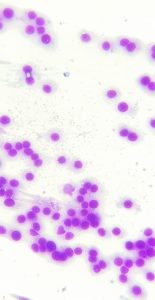Canine Transmissible Venereal Tumour

Suspected TVT seen in vulva of a 1-year old Female Entire Dog
Transmissible Venereal Tumour (TVT) is spread from one dog to another by physical contact between an existing tumour on one dog and abrasions on a mucous membrane (oral, genital) on another. It is commonly seen amongst unsterilized stray dogs. The tumour is commonly seen at the genitals as it spreads during mating. However, in some cases it may arise deep within the reproductive areas and be difficult to see without careful examination. This may lead to a misdiagnosis if assumed that the blood is coming from the urinary tract or other sources.
TVT commonly appears as red fleshy external growths. They sometimes may not be visible and can appear as bleeding from the private part. TVT rarely spreads to other parts of the body. While they are usually progressive, they can spontaneously dwindle in size and disappear in certain cases.

Diagnosis of TVT from a FNA sample
Diagnosis
A fine-needle aspirate (FNA) can be taken under sedation or a biopsy under general anesthesia can be done where a larger piece of tissue is sent to the laboratory for analysis. In cases where metastasis is suspected, chest radiographs and abdominal ultrasound may be performed. A complete blood count, biochemistry profile and urinalysis is routinely done and results are usually within normal ranges.
Treatment
Chemotherapy is the treatment of choice. Vincristine sulfate is given intravenously weekly for 3-6 weeks. The prognosis for remission is good unless there is spread to other organs. Complete surgical excision is often not curative unless it is accompanied with chemotherapy.